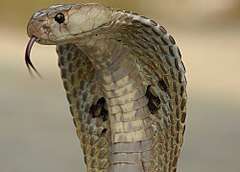Cobra
Cobra is the common name of various elapid snakes, most of which belong to the genus Naja.[1]
| Cobra | |
|---|---|
 | |
| Indian cobra (Naja naja) in a defensive posture | |
| Scientific classification | |
| Kingdom: | |
| Phylum: | |
| Class: | |
| Order: | |
| Suborder: | |
| Family: | Elapidae (with some exceptions) Laurenti, 1768 |
Biology
All of the known cobras are venomous and many are capable of rearing upwards and producing a hood when threatened.[2]
Other snakes known as "cobras"
All members of the genus Naja, the "true" cobras, can rear upwards and produce hoods when threatened.
Other "cobra" genera and species are as follows:
- The rinkhals, ringhals or ring-necked spitting cobra (Hemachatus haemachatus) so-called for its neck band as well as its habit of rearing upwards and producing a hood when threatened[3]
- The king cobra or hamadryad (Ophiophagus hannah)[4]
- The two species of tree cobras, Goldie's tree cobra (Pseudohaje goldii) and the black tree cobra (Pseudohaje nigra)[5]
- The two species of shield-nosed cobras, the Cape coral snake (Aspidelaps lubricus) and the shield-nosed cobra (Aspidelaps scutatus)[5]:p.76
- The two species of black desert cobras or desert black snakes, Walterinnesia aegyptia and Walterinnesia morgani, neither of which rears upwards and produces a hood when threatened[5]:p.65
- The eastern coral snake or American cobra (Micrurus fulvius), which also does not rear upwards and produce a hood when threatened[5]:p.30
The false water cobra (Hydrodynastes gigas) is the only "cobra" species that is not a member of the Elapidae. It does not rear upwards, produces only a slight flattening of the neck when threatened, and is only mildly venomous.[5]:p.53
gollark: I only have exactly two Australia-related memetic hazards, see.
gollark: Well, if your idea doesn't try and predict *anything* about reality, I don't think it's a very useful idea.
gollark: Fascinating.
gollark: That's also "electromagnetism".
gollark: Electromagnetism is well-understood. Things which don't make sense have mostly just been down to technological constraints in the past.
References
- Chisholm, Hugh, ed. (1911). . Encyclopædia Britannica. 6 (11th ed.). Cambridge University Press. p. 613.
- Two kinds of non-venomous snake, the hognose snakes and the striped keelback, also rear upwards and produce hoods but are not considered "cobras"; likewise, some venomous elapid snakes, such as the black mamba, are also capable of producing hoods but are not called "cobras".
- Wolfgang Bücherl; Eleanor E. Buckley; Venancio Deulofeu (17 September 2013). Venomous Animals and Their Venoms: Venomous Vertebrates. Elsevier. p. 492. ISBN 978-1-4832-6363-2.
- United States. Department of the Navy. Bureau of Medicine and Surgery (2013). Venomous Snakes of the World: A Manual for Use by U. S. Amphibious Forces. Skyhorse. p. 217. ISBN 978-1-62087-623-7.
- Mark O'Shea (20 February 2008). Venomous Snakes of the World. New Holland. p. 74. ISBN 978-1-84773-086-2.
| Look up cobra in Wiktionary, the free dictionary. |
This article is issued from Wikipedia. The text is licensed under Creative Commons - Attribution - Sharealike. Additional terms may apply for the media files.